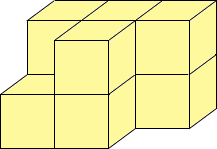Sir.,
I need help to solve this Rules for bulding towers of cubes
| rule 1 | The number of cubes on the bottom layer is always one less than the number of squares on the grid |
| rule 2 | Each new layer is made with one cube less than the layer underneath it. |
- Investigate how many different arrangements there are of 4 cubes on top of 5 cubes on a two by three grid
- investigate the number of different arrangements of six cubes on top of seven cubes on a two by four grid
- investigate the relation between the number of arrangements of cubes and the size of the grid
- when there are two layers of cubes
- when there are more than two layers of cubes
Hi Sanker,
I would approach this problem visually. Actually with two images:
The first image:
| (a) | For the first layer, I would imagine the grid and the blocks
placed. How many ways are there to place 5 blocks on six squares? Alternately, how many ways are there to pick the square with no block on it!
 |
| (b) | Now imagine the five blocks placed in some patttern.
How many ways are there to pick the four blocks to place a block on top
of? Alternately, how many ways are there to pick the one block that will not have a new block on top? [Check that this number does NOT depend on which five squares were covered in the first layer!]
 |
| (c) | Proceed to the next layer (if there are more than two layers) in the same way. |
Therefore you multiple your answers to (a) x (b) [ x(c) if you have more layers].
I think you can figure it out from here. If you are stuck , image a 2x2 grid:
| (a) | How many ways to choose three? (Think of it as choosing one to omit.)
 There are 4 ways. |
| (b) | For each of these, how many ways are there to pick two of these to cover? (Or one to not cover) For each of the 4 options above there are 3 ways to pick two to cover. For example for the first of the 4 options above the three ways are.

|
Hence in total there are 4 x 3 = 12 towers.
Cheers.
Walter